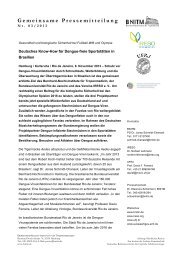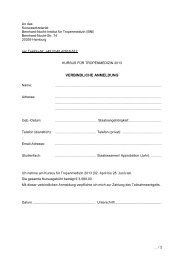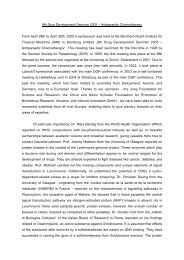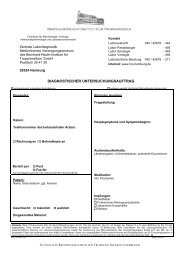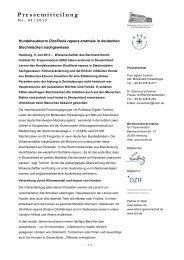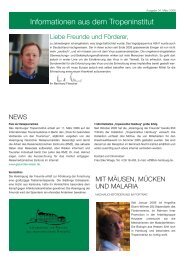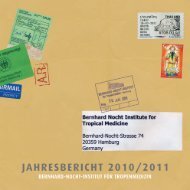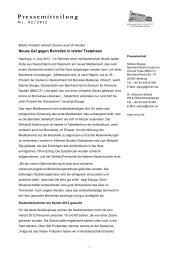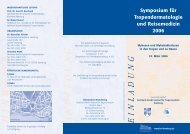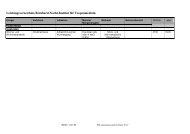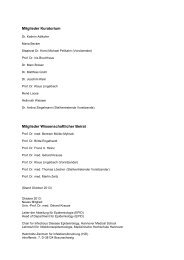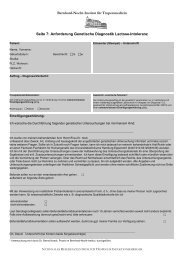Research Group Heussler (Malaria I) - Bernhard-Nocht-Institut für ...
Research Group Heussler (Malaria I) - Bernhard-Nocht-Institut für ...
Research Group Heussler (Malaria I) - Bernhard-Nocht-Institut für ...
Create successful ePaper yourself
Turn your PDF publications into a flip-book with our unique Google optimized e-Paper software.
Clinical Department<br />
Persistence and Reactivation of the Hepatitis B Virus<br />
Zusammenfassung<br />
Die Infektion mit Hepatitis B-Virus muss selbst bei<br />
fehlendem Nachweis von Hepatitis B Oberflächen-<br />
Antigen (HBs-Ag) als nicht ausgeheilt angesehen<br />
werden. In den meisten dieser Fälle treten bis ans<br />
Lebensende keine klinischen Symptome mehr auf.<br />
Bei verschiedenen Formen der Immunsuppression<br />
kann es jedoch zu einer Reaktivierung und unter bestimmten<br />
Bedingungen sogar zu einer fulminanten<br />
Hepatitis kommen.<br />
Summary<br />
Even in case of missing evidence of hepatitis B surfaceantigen<br />
(HBs-Ag), a former infection with hepatitis B virus<br />
cannot be considered to be irreversibly cured. In<br />
most of these cases there are no clinical symptoms for<br />
the rest of the patient’s life. There is, however, the possibility<br />
of reactivation and, under certain circumstances,<br />
even a fulminant hepatitis in cases of various forms of<br />
immunosuppression may occur.<br />
Introduction<br />
For long time it was believed that HBs-negative serology<br />
after infection with hepatitis B-virus (HBV) did<br />
mean that the infection is cured. There were, however,<br />
cases of reactivation, some even accompanied by fulminant<br />
hepatitis in cases of simultaneous chemotherapy<br />
or in cases of immunosuppression by drugs or<br />
by HIV-infection. Modern PCR screening methods have<br />
been developed in the meantime to detect even lowest<br />
virus concentrations.<br />
Project Description and Results<br />
Based on a group of five own cases of acute hepatitis<br />
in HIV-infected patients these cases were analysed systematically<br />
using stored serum samples. It could be<br />
shown that the hepatitis reaction had been caused by a<br />
preceding highly replicative HBV reactivation.<br />
Two further study groups were investigated.<br />
In the first group we used unselected hepatitis B-coreantibody<br />
(anti-HBc)-positive and HBs-Ag-negative analytical<br />
samples. These samples were tested for the frequency<br />
of HBV DNA detection and possible related cofactors.<br />
As a result, in about 12% of the cases HBV replication<br />
was detected, generally at a low level. A simultaneous<br />
chronic hepatitis C but not a concomitant HIVinfection<br />
was a significant risk factor for HBV DNA detection.<br />
The second group consists of an anti-HBc-positive HIV<br />
cohort (504 patients, up to 20 years observation time).<br />
104<br />
Aim of this investigation is a longitudinal analysis of hepatitis<br />
B serum markers and hepatic reactions. Until<br />
now, there are only few published longitudinal data.<br />
Preliminary analyses show a high degree of fluctuation<br />
of the HBs serum markers. This has not been described<br />
so far. Furthermore, the data structure will help to<br />
quantify the number and degree of hepatic reactions in<br />
correlation with certain risk factors such as hepatitis C<br />
co-infection or antiretroviral medication.<br />
Selected Publications<br />
• Christoph Manegold, Anani Apedjinou (2004):<br />
High incidence of fluctuations of hepatitis B<br />
serum markers in HIV-infected patients.<br />
11th Conference on Retroviruses and Opportunistic<br />
Infections, San Francisco 8.-11.2.2004<br />
• Drosten C, Nippraschk T, Manegold C, Meisel H,<br />
Brixner B, Roth WK, Apedjinou A, Günther S (2004):<br />
Risk factors for detection of hepatitis B virus (HBV)<br />
DNA in HBsAg-negative/anti-HBc-positive sera and<br />
analysis of terminal protein sequence of the circulating<br />
HBV DNA. Clin Virol. 29(1): 59-68<br />
• Vieth S, Manegold C, Drosten C, Nippraschk T,<br />
Günther S (2002): Sequence and phylogenetic analysis<br />
of hepatitis B virus genotype G isolated in Germany.<br />
Virus Genes 24 (2): 153-6<br />
• Manegold C, Hannoun C, Wywiol A, Dietrich M,<br />
Polywka S, Chiwakata CB, Gunther S (2001): Reactivation<br />
of hepatitis B virus replication accompanied<br />
by acute hepatitis in patients receiving highly active<br />
antiretroviral therapy. Clin Infect Dis 32 (1): 144-148<br />
Cooperating Partners<br />
• Christian Drosten, Stephan Günther,<br />
Department of Virology, BNI<br />
Investigators<br />
• Christoph Manegold<br />
• Manfred Dietrich



